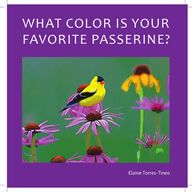
Return to flip book view
WHAT COLOR IS YOUR FAVORITE PASSERINE?Elaine Torres-Tineo
“A hundred thousand birds salute the day” -Christina Georgina Rossetti
WHAT COLOR IS YOUR FAVORITE PASSERINE?A project inspired by a series of art and conservation workshops sponsored by the Lawrence Anthony Earth Organization’s New Jersey Chapter at the Cre8sArt School in Fort Lee.Elaine Torres-Tineo (Project Director)Jason Weisbrot (Artwork)All proceeds to benet the Lawrence Anthony Earth Org., NJ Chapterhttps://www.laeonj.org/ Copyright © 2022, 2023 by Elaine Torres-TineoISBN: 9798867675264
Passerines belong to the largest family of birds and are found in all parts of the world in dierent colors, patterns, shapes and sizes. Also called perching birds, they have the distinct characteristic of having three toes in the front and one strong toe in the back that allows them to comfortably perch on tree branches and other natural surroundings.e allure of the lyrical and colorful passerine is perhaps responsible for getting more people to engage in birding activities that promote science-driven bird conservation eorts. is collaboration -what Lawrence Anthony coined Cooperative Ecology™–demonstrates that all life does best when it works together with other life. Whether in the American backyard or the African bush, passerines play an important role in biodiversity and in maintaining the balance of the ecosystem.
All nine species of coneowers are native to North America. eir blooms become seeds in the fall, transforming into natural bird feeders. Coneowers are beloved by birds, butteries and bees.
1
American Goldnch (North America)
2
American Robin (North America)
3
Baltimore Oriole (North America)
4
Black and White Warbler (North America)
5
Black-capped Chickadee (North America)
6
Black-Napped Monarchs (Asia)
7
Blue Jays (North America)
8
Cedar Waxwing (North America)
9
Common Starlings (Widespread)
10
Eastern Bluebirds (North America)
11
Eurasian Blue Tits
12
Eurasian Bullnches
13
Eurasian Magpies
14
European Goldnches
15
Golden- Hooded Tanagers (Central America)
16
Gouldian Finches (Australia)
17
Grayish Baywings (South America)
18
Great Tits ( Wide spread)
Go to www.laeonj.org/print for more information on the passerines included this book.
19
Male Green Headed Tanager (South America)
20
Green Honeycreepers (Tropical New World)
21
House Sparrows (World Wide )
22
Indigo Bunting (North America)
23
Java Sparrows (Indonesia)
24
Long-tailed Broadbills (Himalayas)
25
Female and Male Cardinal (North & Central America)
26
Orange-headed rush (India & China)
27
Male Painted Bunting (North America)
28
Red-cheeked Cordon-Bleu (Central and Eastern Africa.)
29
Red Crested Cardinals (South America)
30
Red-Winged Blackbird (North & Central America)
31
Scarlet Tanager (North America)
32
Steller Jays (North America)
33
Violet-Backed Starling (Sub-Sahara Africa)
34
Western Tanagers (North America)
35
Yellow Billed Oxpeckers (Sub-Saharan Africa)
36
Yellow Headed Blackbirds (North & Central America)
37
Yellow Warbler (North America)
e Oak tree is the most vital of all tree species for wildlife– especially wild birds. ey host more than 500 species of caterpillars and many other insect species that are consumed by birds. eir fruit the acorn, which many wildlife species rely upon, is also a key component to the winter diet of many birds. In 2004, the oak tree was designated the ocial national tree of the United States.
“e bluebird carries the sky on his back”— Henry David oreau
“As individuals we are responsible for more than just ourselves and our own kind. There is more to life than just these. We must each one of us also bring the natural world back into proper perspective in our lives and realize that doing so is not some lofty ideal, but a vital part of our personal survival”.Lawrence Anthony (1950-2012)Born in 1950 in Johannesburg, South Africa, Lawrence Anthony was a passionate environmental-ist and wildlife conservationist. His life, vision and many conservation undertakings are memori-alized in his books: Babylon’s Ark (2007) about his eorts to save the animals in the Baghdad Zoo during the early stages of the Iraq War; The Elephant Whisperer (2009) about his relationship with a herd of wild elephants; and The Last Rhino, published posthumously in 2012, about his eorts to save the rare northern white rhino species from extinction by meeting with leaders of the rebel group the Lord’s Resistance Army. All co-written with author Graham Spence.In 2003 Dr. Anthony founded The Earth Organization. After he passed away in 2012, The Earth Organiza-tion was renamed in his honor. “With more than 20 chapters worldwide, the Lawrence Anthony Earth Organization continues to work towards the achievement of his vision – a healthy, safe, aesthetic world where all life can ourish. Their many science-based projects around the world carry forward with this goal in mind, including educational programs designed to raise awareness of the vital partnership for survival all life forms have with each other. He termed this subject “Cooperative Ecology™”.The mission of the New Jersey Chapter is to promote a better understanding of the environment and wildlife conservation through its various art programs. For more information, please visit https://www.laeonj.org/NEW JERSEYCHAPTER